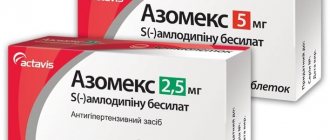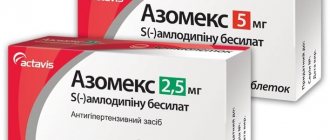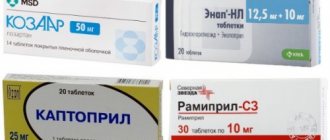Compound
Coated tablets contain 10 mg of nifedipine each as an active substance. Excipients: polyvinyl butyral in an amount of 0.7 mg; talc (1 mg); 0.3 mg magnesium stearate ; 4 mg hydroxypropylcellulose ; lactose monohydrate (15 mg); croscarmellose sodium (13 mg); microcellulose (46 mg). The shell consists of hypromellose - 2.63 mg; titanium dioxide CI 77891 - 0.82 mg; yellow iron oxide - 0.3 mg and magnesium stearate - 0.25 mg.
Long-acting film-coated tablets contain the same active substance, but in a dose of 20 mg. Each of them contains the following substances as auxiliary substances: microcellulose (99 mg); lactose monohydrate (30 mg); croscarmellose sodium (26 mg); copolymers of methyl methacrylate and ethyl methacrylate in a ratio of 1:2 (1.9 mg); talc (2 mg); magnesium stearate (0.6 mg); hyprolose (0.5 mg). The film shell is made of hypromellose - 5.26 mg; titanium dioxide - 1.64 mg; red iron oxide - 0.6 mg; magnesium stearate - 0.5 mg.
Release form
There are two options for the release form of the drug:
- Coated tablets, weighing 10 mg. Every 100 tablets are placed in a brown glass bottle. The bottles are individually packaged in cardboard boxes.
- Film-coated tablets with prolonged action. Each tablet weighs 20 mg. Place 30 or 60 tablets in brown glass bottles. Vials must be sealed with polyethylene caps that have a first-opening control. The bottle is packed in a cardboard box.
Pharmacodynamics and pharmacokinetics
Nifedipine is a selective blocker of slow calcium channels, one of the 1,4-dihydropyridine derivatives. Its effect is manifested in a decrease in the flow of extracellular calcium ions into cardiomyocytes and smooth muscle cells of the arteries. Nifedipine can also increase renal blood flow, causing moderate natriuresis .
After taking one tablet of Cordaflex, which has a prolonged action, the clinical effect usually develops after 20 minutes, the effect lasts from 12 to 24 hours.
After administration, it is quickly, almost completely (at least 90%) absorbed from the digestive tract. And the bioavailability of the drug is in the range of 40-70%.
The maximum concentration of the active substance in the blood is found 30-60 minutes after taking the drug.
After taking one tablet with a prolonged action, the therapeutic concentration in the blood plasma is achieved within an hour and remains at an equal level for up to 6 hours; over the next 30-36 hours, a gradual decrease in concentration is observed.
Nifedipine has the property of binding to blood plasma proteins, in particular albumins , penetrating the blood-brain barrier (in small quantities - no more than 5%), through the placenta , and can be excreted in breast milk.
The half-life is 2 hours for a 10 mg tablet; for a 20 mg extended-release tablet it is approximately 3.8-16.9 hours.
conclusions
Cordaflex is a highly effective antianginal and antihypertensive agent from the group of calcium channel blockers. Due to this, as well as its low cost, it has become widespread in the treatment of acute attacks of cardiovascular diseases.
However, it has a number of contraindications and can also cause various adverse reactions. The most common is a sharp drop in blood pressure. To avoid them, you must strictly adhere to dosages and recommendations for use.
Contraindications
Contraindications are:
- intolerance to nifedipine , other 1,4-dihydropyridine , additional components included in the tablets;
- arterial hypotension;
- unstable angina;
- the current or recent presence of acute myocardial infarction or severe aortic stenosis ;
- idiopathic subaortic stenosis;
- chronic heart failure during the period of decompensation;
- childhood.
It is prescribed with special caution to elderly patients, those with impaired renal function, and patients with diabetes mellitus .
Side effects
Cordaflex is usually well tolerated. Side effects appear rarely, more often at the beginning of treatment (then they may become weaker or disappear).
There are such side effects:
- On the heart and blood vessels: decreased blood pressure, flushing of the face and torso, swelling in the extremities , accelerated heart rate, paradoxical attack of angina , development of acute heart failure .
- On the nervous system: increased fatigue , dizziness , weakness , emotional lability , sleep disturbances, headache, tremor , paresthesia .
- On the gastrointestinal tract: the occurrence of heartburn , nausea , vomiting , flatulence , stool disorders, dryness or inflammation of the oral mucosa, intrahepatic cholestasis , as well as increased activity of certain liver enzymes.
- On the circulatory system: thrombocytopenia , leukopenia , anemia .
- On the urinary system: increased daily diuresis, night urination , decreased renal function.
Allergic reactions may occur in the form of urticaria , exanthema , and skin itching .
Results and discussion
The effectiveness of combinations of antihypertensive drugs is presented in table. 2.
Table 2. Efficacy of antihypertensive drugs
As can be seen from table. 2, combinations of moxonidine with nifedipine, moxonidine with furosemide, and captopril with furosemide were very highly effective. In contrast, the addition of nifedipine to captopril resulted in a sharp decrease in antihypertensive activity.
The absence of increased antihypertensive activity when adding amlodipine to captopril is also indicated by P. Kotruchin et al. [12].
Changes in blood pressure 30 minutes after taking the studied combinations of antihypertensive drugs are presented in the figure.
Decrease in systolic (a) and diastolic blood pressure (b) after taking antihypertensive drugs. 1 — moxonidine with nifedipine; 2 — moxonidine with furosemide; 3 — captopril with nifedipine; 4 — captopril with furosemide.
Combinations of moxonidine with nifedipine, moxonidine with furosemide and captopril with furosemide have pronounced antihypertensive activity (see figure). SBP is more significantly reduced by the combination of moxonidine with furosemide, and DBP by the combination of moxonidine or captopril with furosemide.
The combination of captopril with nifedipine for emergency antihypertensive therapy is ineffective.
In table 3 presented
Table 3. Adverse events of antihypertensive drugs - undesirable effects of the studied combinations of antihypertensive drugs.
As can be seen from table. 3, the least number of adverse events occurred when using a combination of moxonidine with furosemide, the maximum number of side effects was noted when captopril was prescribed with nifedipine.
As a result of the analysis of 498 emergency medical service call cards for patients with elevated blood pressure, it was found that initially during the year they called for emergency medical services 1724 times, i.e., there were 3.5 calls per patient per year. After receiving recommendations for self-help, more than half (279 out of 498) of patients with increased blood pressure did not call for emergency medical services within a year. The remaining 219 patients visited the emergency room for this issue 656 times during the year, i.e., the number of calls per patient decreased from 3.5 to 3.0 per year.
On average, the introduction of individual recommendations for self-help reduced the use of emergency medical services in connection with an increase in blood pressure from 1724 to 656 per year, i.e. by 2.6 times, without requiring additional funding.
The high incidence of arterial hypertension, the low effectiveness of its treatment, the round-the-clock availability of emergency medical services, together with the dependent attitude of patients towards their disease, are realized by the very high demand for emergency medical services at the slightest increase in blood pressure.
The increasing number of calls depletes the resources of the ambulance service and healthcare in general, not improving the course and outcome of the disease, but contributing to the transformation of a medical problem into a social problem.
Solving this problem is impossible without the cooperation of the doctor and the patient with arterial hypertension, in particular without the active use of self-help. Combinations of drugs for self-help should be selected during emergency medical care, so that both the doctor and the patient can be convinced of the effectiveness and good tolerability of the drugs.
When using self-help, you should adhere to the rules, the main ones of which are presented below.
Basic rules of self-help
1. Self-help is indicated for a typical deterioration of the patient’s condition, in particular for a typical increase in blood pressure.
2. The doctor must make sure that the patient correctly understands the content of self-help and is able to correctly follow the specified recommendations.
3. If, after taking the recommended medications, your health and condition do not improve or worsen, it is necessary, without wasting time, to call an ambulance.
4. Self-help should not replace planned therapy.
5. Self-help should not be prescribed to patients who are unable to adequately assess and control their condition.
Instructions for use of Cordaflex (Method and dosage)
The drug is taken orally. 10 mg film-coated tablets are swallowed whole before meals with water.
The dosage is set individually, as it very much depends on the severity of the disease, the type of disease and the body’s response to the therapy. Start with 1 tablet (10 mg) 3 times a day. There should be at least 2 hours between doses of the drug. The maximum dose per day is 40 mg.
Long-acting film-coated tablets are swallowed whole and washed down with water. In this case, the initial dose is 1 tablet 2 times a day. In any case, the daily dose is divided into 2 doses, between which a 12-hour interval must be observed.
According to the instructions for use of Cordaflex, discontinuation of the drug should be carried out gradually.
Comparison of addiction between Cordaflex and Nifedipine
Like safety, addiction also involves many factors that must be considered when evaluating a drug.
So, the totality of the values of such parameters as “o syndrome” in Cordaflex is quite similar to the similar values in Nifedipine. Withdrawal syndrome is a pathological condition that occurs after the cessation of intake of addictive or dependent substances into the body. And resistance is understood as initial immunity to a drug; in this it differs from addiction, when immunity to a drug develops over a certain period of time. The presence of resistance can only be stated if an attempt has been made to increase the dose of the drug to the maximum possible. At the same time, Cordaflex has a fairly low “syndrome” value, just like Nifedipine.
Overdose
An overdose of nifedipine may cause the following consequences:
- arterial hypotension;
- chest pain (similar to an angina );
- tachycardia;
- loss of consciousness;
- collapse;
- ventricular or nodal extrasystole ;
- bradycardia.
In severe cases, the development of metabolic alkalosis , cardiogenic shock with pulmonary edema, hypoxia , hyperkalemia , as well as disturbances of consciousness, which can progress to coma .
Interaction
Cordaflex should not be administered with alcohol-containing medications.
Orthostatic hypotension may develop when used with methyldopa , clonidine , as well as prazosin and octadine .
Cimetidine , ranitidine and tricyclic antidepressants will potentiate the antihypertensive effect .
When Cordaflex is combined with theophylline and digoxin , it is necessary to monitor the plasma concentrations of these drugs, as they may increase.
Phenytoin , calcium supplements and rifampicin reduce the effect of nifedipine .
Cordaflex reduces the rate of elimination of vincristine , which increases the risk of side effects. Therefore, dose adjustment is necessary.
Erythromycin , diltiazem , grapefruit juice in large quantities, azole antimicrobial drugs when taken with nifedipine significantly slow down its metabolism.
Comparison of safety of Cordaflex and Nifedipine
The safety of a drug includes many factors.
At the same time, in Cordaflex it is quite similar to Nifedipine. It is important where the drug is metabolized: drugs are excreted from the body either unchanged or in the form of products of their biochemical transformations. Metabolism occurs spontaneously, but most often involves major organs such as the liver, kidneys, lungs, skin, brain and others. When assessing the metabolism of Cordaflex, as well as Nifedipine, we look at which organ is the metabolizing organ and how critical the effect on it is.
The risk-benefit ratio is when the prescription of a drug is undesirable, but justified under certain conditions and circumstances, with the obligatory observance of caution in use. At the same time, Cordaflex does not have any risks when used, just like Nifedipine.
Also, when calculating safety, it is taken into account whether only allergic reactions occur or possible dysfunction of the main organs. In other matters, as well as the reversibility of the consequences of using Cordaflex and Nifedipine.
Cordaflex analogues (drugs that have a similar effect)
Level 4 ATC code matches:
Lacipil
Cordafen
Azomex
Nimodipine
Felodipin
Nifedipine
Farmadipin
Amlotop
Nimotop
Tenox
Nifecard HL
Cordipin
Felodip
Normodipine
Phenigidine
Norvask
Lerkamen
Corinfar
Vero-Amlodipine
Amlodipine
Analogs are the following drugs: Adalat , Vero-Nifedipine , Calcigard Retard , Zanifed , Cordafen , Cordaflex Retard , Cordipin , Cordipin Retard , Cordipine XL Corinfar , Nifedicap , Nifedipine and some other drugs.
Cordaflex Retard has particularly similar pharmaceutical characteristics and therapeutic applications.
Comparison of side effects of Cordaflex and Nifedipine
Side effects or adverse events are any adverse medical event that occurs in a subject after administration of a drug.
Cordaflex has more side effects than Nifedipine. This implies that the frequency of their occurrence is low with Cordaflex and low with Nifedipine. Frequency of manifestation is an indicator of how many cases of an undesirable effect from treatment are possible and registered. The undesirable effect on the body, the strength of influence and the toxic effect of drugs are different: how quickly the body recovers after taking it and whether it recovers at all. When using Cordaflex, the body's ability to recover faster is higher than that of Nifedipine.
Cordaflex price, where to buy
The price for 10 mg tablets is 72-95 rubles for 10 pieces, for 20 mg tablets – 63-139 rubles for 30 pieces, 74-168 rubles for 60 pieces.
- Online pharmacies in RussiaRussia
ZdravCity
- Cordaflex tablets p.p.o.
prolonged action 20 mg 60 pcs. Egis 128 rub. order - Cordaflex tab. p.o 10 mg n100Egis
96 RUR order
- Cordaflex RD tablets p.p.o. with control release 40 mg 30 pcs Arena Pharmaceuticals GmbH/Egis
190 rub. order
- Cordaflex tablets p.p.o. prolonged action 20 mg 30 pcs. Egis
95 rub. order


